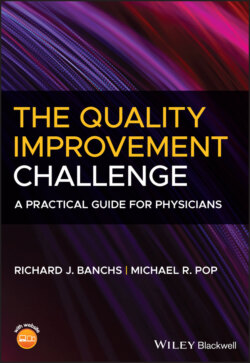Читать книгу The Quality Improvement Challenge - Richard J. Banchs - Страница 38
A PROJECT TYPE FOR EVERY PROBLEM
ОглавлениеProject strategy and resource requirements vary according to the specific type of project that is undertaken. While all projects follow the principles of improvement described in previous pages, not all projects require the same amount of effort, resources, tools, data, or statistical analysis. In the clinical arena, there are several project types and approaches to improvement. We have chosen to call them type I, type II, and type III.
Type I. These are the quick wins and “just do it” projects. These are rapid‐improvement projects usually initiated by an individual or a small team to address a simple problem that affects a limited area. People are just trying to make their workflow or work environment better. This type of project usually seeks a practical and inexpensive solution, which is typically already known or requires little investigation. The project needs a loose framework and can be done in a couple of days. Examples of a project type I are: Improve the organization and prioritization of incoming faxes; make sure patient demographic information is documented in the chart accurately and in a timely fashion; organize a supply room.
Type II. The project addresses a simple performance problem that affects a small area or department. The root causes of the problem may be known or unknown, but the solution in general is not known. The project requires some data, the use of some improvement tools, and basic statistics. There is a low to moderate risk if the solution fails. These projects are done using different frameworks and tools. For example
Kaizen events. A Kaizen event (the word comes from the Japanese) is a focused, short‐term project event attended by leaders, mid‐level managers, and frontline staff and providers to make improvements to an existing process for which they are responsible for. A Kaizen event is traditionally scheduled as a week‐long event.
A3 projects. A3 is a structured problem‐solving and continuous improvement approach that is simple, visual, and provides a structure to guide individuals or teams in problem solving. The approach typically uses a single sheet of ISO‐A3‐size paper to document all the information that relates to the project. The A3 sheet includes seven common sections: background, current conditions, goals, analysis, solutions, plan for improvement, and follow‐up.
Rapid Cycle Improvement. A team leader takes mid‐level managers and frontline staff and providers through a four‐step improvement cycle called the PDSA cycle: Plan‐Do‐Study‐Act (see chapter 21). The PDSA cycle helps the team understand the problem, formulate a hypothesis, develop a solution, create a plan of action, test the solution, and learn from the experience. Solutions are developed quickly and implementation can be done rapidly.
Type III. These projects require the engagement of a formal QI team in order to address a complex performance problem that affects a core process. These are big projects. The root causes of the problem and the solution/s are unknown. These projects usually require the QI team to come up with a multifaceted solution. The change will affect multiple departments and/or locations, and may impact a large number of people. Type III improvement projects require an in‐depth analysis of the problem, a stepwise structured approach, and a large amount of data used for statistical analysis. There is high organizational risk if the solution fails. Adequate resources and leadership are critical. Examples: Improve throughput in the Emergency Department; improve turnover time in the operating rooms; decrease complication rates on the patient care units.
